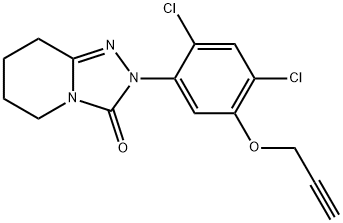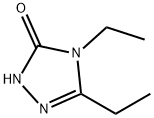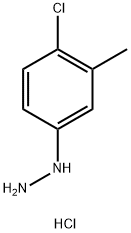azafenidin
- CAS NO.:68049-83-2
- Empirical Formula: C15H13Cl2N3O2
- Molecular Weight: 338.19
- MDL number: MFCD30720402
- SAFETY DATA SHEET (SDS)
- Update Date: 2024-12-18 14:08:57

What is azafenidin?
The Uses of azafenidin
Azafenidin is a weed controlling herbicide used in various crops.
The Uses of azafenidin
Herbicide.
Definition
ChEBI: Azafenidin is a triazolopyridine that is 5,6,7,8-tetrahydro[1,2,4]triazolo[4,3-a]pyridin-3(2H)-one which is substituted at position 2 by a 2,4-dichloro-5-(prop-2-yn-1-yloxy)phenyl group. A protoporphyrinogen oxidase inhibitor, it is used as a herbicide to control weeds in fruit crops such as pineapple, citrus, melons, and grapes. Not approved for use within the European Union. It has a role as an EC 1.3.3.4 (protoporphyrinogen oxidase) inhibitor. It is a triazolopyridine, a terminal acetylenic compound and a dichlorobenzene.
Metabolic pathway
A common degradation reaction of azafenidin in light, plants and soil is O-dealkylation, and interesting minor reactions in soil are the subsequent methylation of the O-dealkylated degradation product and the reduction of the propynyl group under anaerobic conditions. In soil and light, azafenidin is also readily split to form the triazolinone heterocycle. Azafenidin is readily metabolized in rats and lactating goats through O-dealkylation, hydroxylation of the triazolinone ring in several positions, and glucuronide and sulfate conjugation.
Properties of azafenidin
| Melting point: | 168-168.5° |
| Boiling point: | 468.9±55.0 °C(Predicted) |
| Density | 1.43±0.1 g/cm3(Predicted) |
| solubility | DMSO (Slightly), Methanol (Slightly) |
| pka | 2.45±0.20(Predicted) |
| form | Solid |
| color | Brown to Dark Brown |
| EPA Substance Registry System | Azafeniden (68049-83-2) |
Safety information for azafenidin
Computed Descriptors for azafenidin
New Products
(S)-3-Aminobutanenitrile hydrochloride 4-Methylphenylacetic acid N-Boc-D-alaninol N-BOC-D/L-ALANINOL Tert-butyl bis(2-chloroethyl)carbamate 3-Morpholino-1-(4-nitrophenyl)-5,6-dihydropyridin- 2(1H)-one Furan-2,5-Dicarboxylic Acid Tropic acid 1-Bromo-3,5-Di-Tert-Butylbenzene S-2-CHLORO PROPIONIC ACID ETHYL ISOCYANOACETATE 2-Bromo-1,3-Bis(Dimethylamino)Trimethinium Hexafluorophosphate 4-IODO BENZOIC ACID 3-NITRO-2-METHYL ANILINE 1-(2,4-DICHLOROPHENYL) ETHANAMINE (2-Hydroxyphenyl)acetonitrile 4-Bromopyrazole 2-(Cyanocyclohexyl)acetic acid 4-methoxy-3,5-dinitropyridine 1-(4-(aminomethyl)benzyl)urea hydrochloride 2-aminopropyl benzoate hydrochloride diethyl 2-(2-((tertbutoxycarbonyl)amino) ethyl)malonate tert-butyl 4- (ureidomethyl)benzylcarbamate Ethyl-2-chloro((4-methoxyphenyl)hydrazono)acetateRelated products of tetrahydrofuran
![2-(2,4-DICHLORO-PHENYL)-5-METHYL-2,4-DIHYDRO-[1,2,4]TRIAZOL-3-ONE](https://img.chemicalbook.in/CAS/GIF/79604-49-2.gif)






You may like
-
 2033-24-1 98%View Details
2033-24-1 98%View Details
2033-24-1 -
 42831-50-5 5-METHYLISOXAZOLE-4-CARBOXYLIC ACID 98%View Details
42831-50-5 5-METHYLISOXAZOLE-4-CARBOXYLIC ACID 98%View Details
42831-50-5 -
 1975-50-4 98%View Details
1975-50-4 98%View Details
1975-50-4 -
 2-HYDROXY BENZYL ALCOHOL 98%View Details
2-HYDROXY BENZYL ALCOHOL 98%View Details
90-01-7 -
 2-Chloro-1,3-Bis(Dimethylamino)Trimethinium Hexafluorophosphate 221615-75-4 98%View Details
2-Chloro-1,3-Bis(Dimethylamino)Trimethinium Hexafluorophosphate 221615-75-4 98%View Details
221615-75-4 -
 61397-56-6 CIS BROMO BENZOATE 98%View Details
61397-56-6 CIS BROMO BENZOATE 98%View Details
61397-56-6 -
 14714-50-2 (2-Hydroxyphenyl)acetonitrile 98+View Details
14714-50-2 (2-Hydroxyphenyl)acetonitrile 98+View Details
14714-50-2 -
 118753-70-1 98+View Details
118753-70-1 98+View Details
118753-70-1